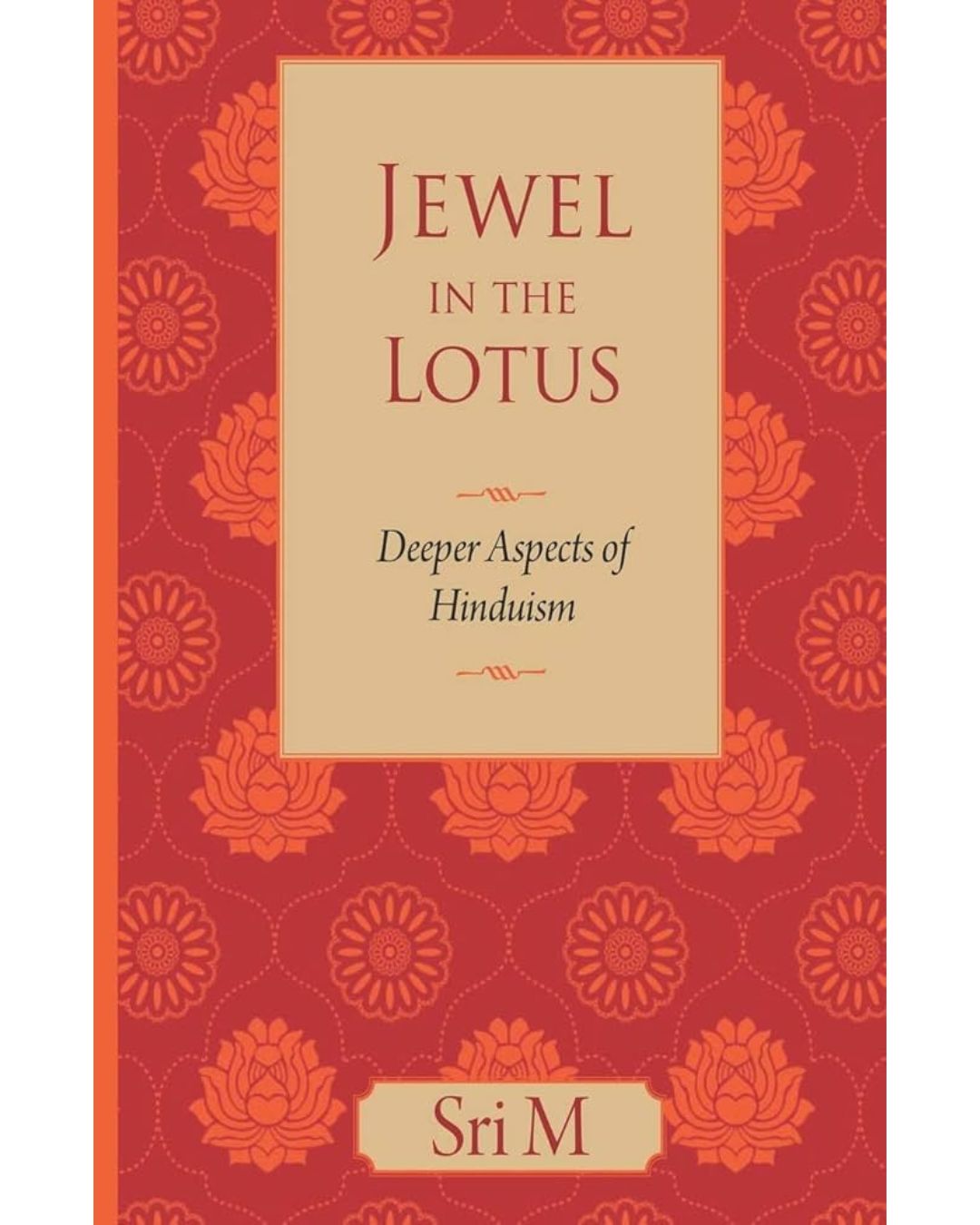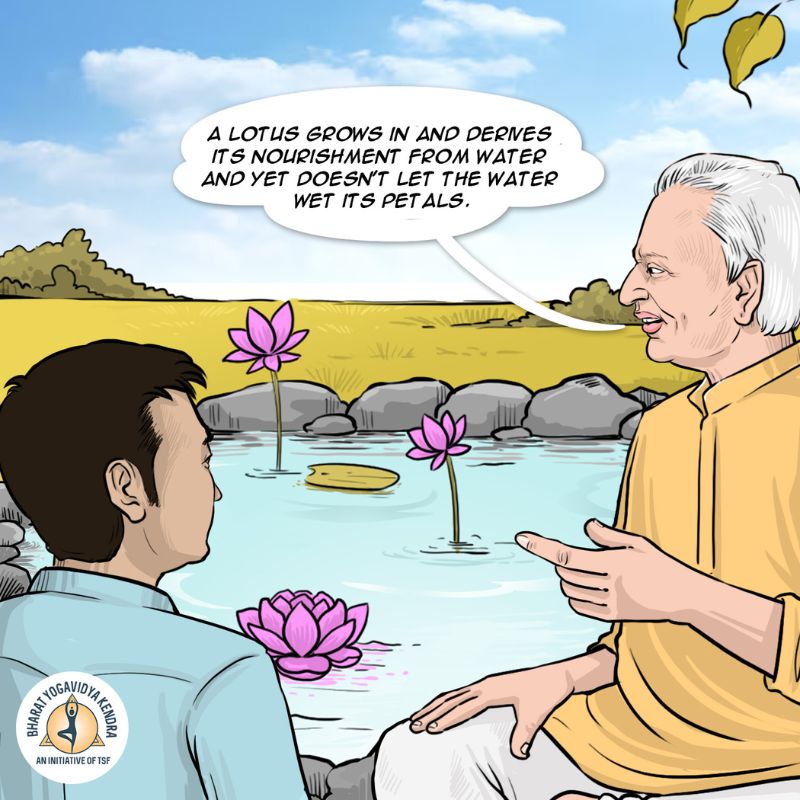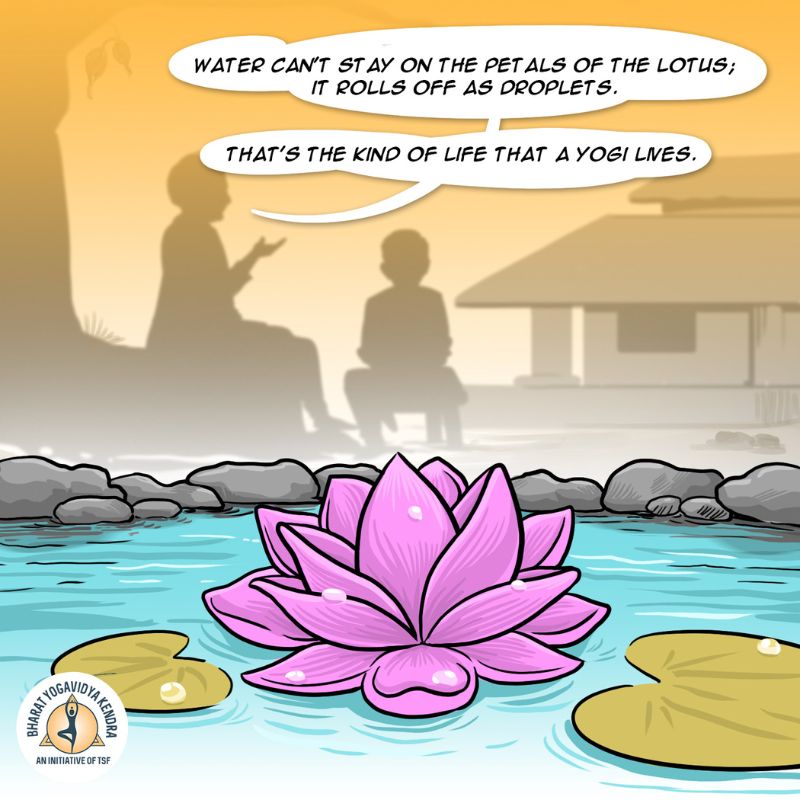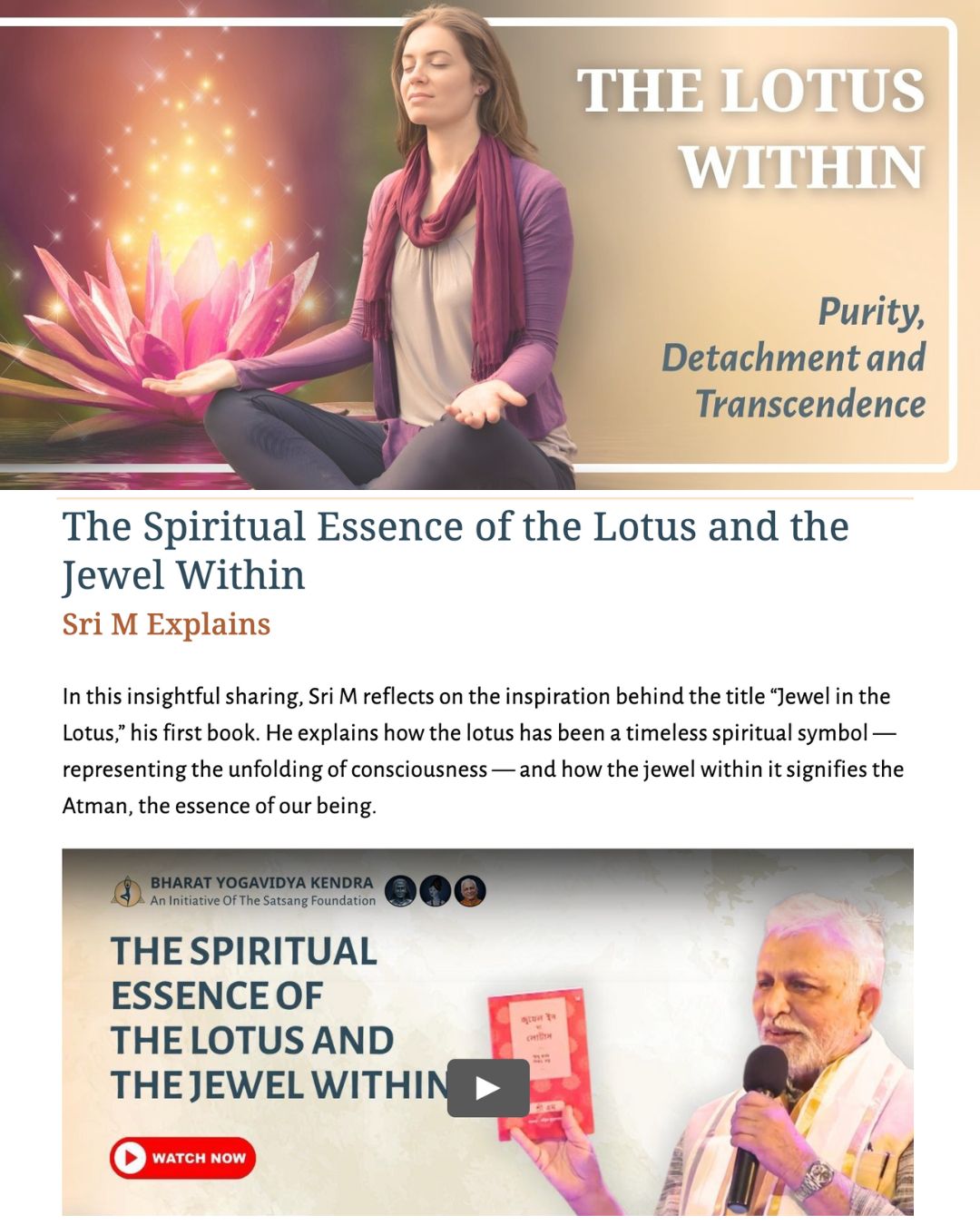The Lotus Within: Purity, Detachment, Transcendence
The lotus begins where we hesitate to look—mud, silt, the dense weave of habit. Yet it rises clean. Sri M often points to this image: the jewel is not elsewhere; it opens from within when life is lived simply and the mind sits still. Petal by petal, the heart remembers its native clarity.
Purity is not spotless living; it is honest living. We see what stains attention—resentment, show, the need to win—and stop giving it our breath. Then the water beads and slips; the leaf remains cool.
Detachment is not indifference. It is warm hands that do the work and let the fruit go. Like the stem that holds the flower above the pool, discipline holds us above the daily swirl: practice at dawn, truthful speech, food that lightens, company that steadies.
Transcendence is not escape. It is depth. The root stays in the world; the bloom meets the light. Between them is a still axis—awareness—that does not drown in either.
This month, keep a Kumbh-like spirit of sādhanā: a quiet vow, a daily “bath” in mantra or breath, a small renunciation that clears space for what matters. Let the mind return again and again to the inner shrine where the jewel is already shining.
Rise from where you are. Keep the root, lift the face. Let the day pass over you without residue.
Om Tat Sat.
The Spiritual Essence of the Lotus and the Jewel Within
Sri M Explains
In this insightful sharing, Sri M reflects on the inspiration behind the title “Jewel in the Lotus,” his first book. He explains how the lotus has been a timeless spiritual symbol — representing the unfolding of consciousness — and how the jewel within it signifies the Atman, the essence of our being.
Talk with M
BLOG POST
The Lotus Within – Purity, Detachment and Transcendence
Universal Symbol for Spiritual Growth

“I surrender to thy lotus feet” is a spiritual expression of total submission. It signifies devotion and seeking refuge in a divine being. The Bhagavad Gita highlights the importance of detachment and surrender to Krishna. He assures Arjuna that those who take refuge in him will find eternal peace. This teaching inspires millions to seek His grace to transcend worldly struggles. It encourages a focus on inner spiritual growth.
The phrase symbolizes offering all of one’s self to the divine. It involves trusting in divine grace and guidance. Believing that such an act can lead to spiritual liberation. The “lotus feet” represent the divine’s purity, grace, and transcendence, untouched by worldly impurities.
The lotus flower holds profound spiritual significance across various cultures, symbolizing purity, enlightenment, and spiritual growth. Its journey from muddy waters to the surface, where it blooms in pristine beauty, serves as a powerful metaphor for personal transformation and the pursuit of higher consciousness.
The lotus remains an emblem of potential within all. It signifies the ability to rise above challenges in Hinduism, Buddhism, or ancient Egyptian belief systems. It represents the ability to attain spiritual clarity. In ancient Egypt, the blue lotus was a symbol of rebirth and the sun. It was associated with the sun god Ra and believed to have the power to bring life and light. The Egyptians saw the flower’s daily opening and closing as a symbol of life, death, and rebirth. This symbol aligned with their beliefs in the afterlife.
The flower’s petals and leaves shed water easily. They signify detachment from material desires and distractions. This is an essential principle in meditative practices. The blooming lotus represents the process of spiritual growth. It signifies the unfolding of wisdom. This is much like how the flower slowly opens its petals. The blooming of the lotus is used to describe the progression from ignorance to full enlightenment.
The lotus is also referenced in the heart chakra, called Anahata, in yogic philosophy. This chakra is symbolized by a lotus with 12 petals and represents compassion, love, and spiritual balance. Many meditation practices focus on this chakra to cultivate a deeper sense of inner peace and love for all beings.
The Lotus teaches us the importance of staying grounded while aspiring to higher spiritual realms. By reflecting on the lotus during meditation or spiritual practice, individuals can internalize its lessons of resilience, detachment, and transformation. The lotus, in its simplicity and beauty, offers a profound message of hope, renewal, and the eternal quest for enlightenment.
Padmasana (Lotus Posture for sitting) – The cross-legged posture is considered a stable foundation for long hours of meditation. It symbolizes a state of stillness and focus. The pose is a prime example of “Sthira Sukham Asana”. It is a steady and comfortable posture described by Patanjali in the Yoga Sutras. This pose provides a stable foundation for meditation. This 15th-century text Hatha Yoga Pradipika states that Padmasana is the “destroyer of all diseases.” It is also a way to awaken Kundalini energy.
The Lotus finds prominent place in the emblem of the Ramakrishna order designed by Swami Vivekananda. It is a profound symbol of harmony and meditation in this age of conflict and disharmony. The goal is to realize one’s real Self, the self-effulgent Atman, in this very life. The Swan in the emblem represents this realization. Through this, one becomes free of all limitations, bondages, and littleness.
The meaning behind this emblem, in the language of Vivekananda himself is a wonderful explanation of what every sadhak strives for :
“The wavy waters in the picture are symbolic of Karma, the lotus of Bhakti, and the rising-sun of Jnana. The encircling serpent is indicative of Yoga and awakened Kundalini Shakti, while the swan in the picture stands for Paramatman. Therefore, the ideal of the picture is that by the union of Karma, Jnana, Bhakti and Yoga, the vision of the Paramatman is obtained”
BOOK REVIEW
Jewel in the Lotus by Sri M

At the onset, when I was browsing for a book on Yoga and Philosophy, I chanced upon the book Jewel in the Lotus by Sri M.
At first, I presumed that it may be something very esoteric and not easily relatable to. However, as I started reading the book, I found it deeply insightful and did not want to put the book down. In a very simple yet profound style, Sri M weaves together wisdom, devotion, and the subtle beauty of the inner journey.
What I found most moving is the sincerity that flows through every page — it feels less like reading a book and more like sitting at the feet of a wise teacher. The stories, reflections, and gentle guidance inspire self-inquiry and remind us that the “jewel” of truth is always within.
The book weaves together themes of self-inquiry, meditation, ethical living, and the unity of all faiths, offering a universal approach to spirituality. Sri M emphasizes that true transformation arises from awareness, love and service, rather than ritual or doctrine. Through reflections on the guru–disciple relationship, karma, dharma, and the practice of silence, he guides readers toward discovering the divine within themselves.
This book left me with a sense of awe and renewed inspiration. Jewel in the Lotus is a timeless companion for any seeker, offering light for those who walk the path inward, and strength and clarity for those who strive to live a life of meaning in the modern world. A must read for one and all.
YOGA GUIDE
Inner Lotus: Serenity, Freedom, and Transcendence
Evokes profound spiritual symbolism—purity emerging from murky waters, detachment from worldly distractions, and transcendence into higher states of consciousness.
Padmasana (Lotus Pose)

Padmasana embodies the lotus flower itself, symbolizing purity and spiritual awakening. It creates a stable, meditative seat that supports deep concentration and detachment.
- Sit on the floor with legs extended.
- Bend the right knee and place the right foot on the left thigh, sole facing upward, close to the hip.
- Bend the left knee and place the left foot on the right thigh in the same manner.
- Keep the spine erect, chest open, and shoulders relaxed.
- Rest hands on the knees in Chin Mudra (thumb and index finger touching), symbolizing consciousness and unity.
- Close the eyes softly and maintain a calm, steady breath.
- Hold for 5-15 minutes or as comfortable, cultivating inner purity and centeredness.
Pranayama: Ujjayi Pranayama (Victorious Breath)

Ujjayi breath fosters focused awareness and calm detachment, creating a subtle internal heat that supports transcendence and deep meditative states.
- Sit comfortably in Padmasana or any seated posture with a straight spine.
- Slightly constrict the back of the throat (glottis) to create a soft hissing sound during inhalation and exhalation, like ocean waves.
- Breathe deeply and evenly through the nose, maintaining the audible sound throughout.
- Keep the breath smooth and controlled, neither too fast nor too slow.
- Focus on the sound and rhythm of the breath as a tool for anchoring the mind.
- Practice for 5-10 minutes, cultivating inner calm and transcendent awareness.
This combination of Padmasana and Ujjayi Pranayama mirrors the lotus’s symbolism – rooted yet pure, detached yet fully present, and opening toward transcendence. It invites practitioners to embody the jewel within, awakening clarity and spiritual radiance.
YOGA RESOURCE
Sacred Bloom: Purity, Non-attachment, Enlightenment
The lotus has long been a sacred symbol in the teachings of sages, seers, and saints. Across traditions, it speaks of the soul’s journey from darkness to light, from ignorance to awakening. Rooted in the mud, yet untouched by it, the lotus embodies the highest ideal of spiritual living — purity amidst imperfection, balance amidst turmoil, and beauty amidst challenges.
The great masters often remind us that true purity is not the absence of the world but the ability to remain untainted by it. Like the lotus resting upon water without getting wet, the awakened being lives in the world yet remains above its dualities. Detachment, then, is not indifference but freedom — the ability to act with compassion, love, and wisdom without the binding cords of desire or aversion.
To transcend is to unfold the lotus of consciousness within, petal by petal. Through self-discipline, reflection, and devotion, one rises from the muddy waters of ego and ignorance toward the light of self-realization. The fragrance of such a life inspires others, just as the blooming lotus beautifies even the murkiest pond.
Swami Vivekananda often reminded seekers that the divine nature of man is not to be acquired, but to be realized. The lotus within symbolizes this realization—the awakening of the pure Self that has always been free. To live in the world, to act with compassion and strength, yet remain detached like the lotus leaf from water, is the essence of yoga.
Ramana Maharshi likened the Self to a still lake upon which the reflections of the world play and fade. The wise do not chase the ripples; they rest in the depth beneath. When one turns inward, tracing the source of thought to the silent heart, the fragrance of the lotus of consciousness spreads naturally. Such is transcendence—not an escape from life, but freedom in the midst of it.
The sages tell us: do not strive to escape the mud, as lotus does not reject the mud; it rises beyond it. It draws nourishment from the same earth where impurity lies, yet remains untouched by it. This is the emblem of true spiritual living. Grow so tall, so radiant in your awareness, that nothing can make you impure. The lotus within you already knows the way to the sun.
TESTIMONIALS
Digital Detox & Inner Recharge
Namaste,
Thank you for a wonderful experience over the past 2.5 days.
The instructors were top notch in both making us do yoga and explaining various philosophies involved in simplistic terms. Their friendly nature made them very approachable.
The ambience, hospitality, accommodation, facilities, housekeeping, kitchen staff, etc all deserve a 5 star rating.
The trek to the hillock added on as an activity to remember.
The program schedule was well designed with more scope for inclusion of an additional activity on day 2 (Saturday) as an improvement going forward.
Pranams for teaching the stotras and bhajans, they were elevating.
Overall a very refreshing experience and look forward to connect for another program in the future.
Thanks a lot
-Akshar
Ayurvedic Wisdom

Purity, Detachment and Transcendence in Ayurveda are fundamental principal of mental and spiritual health, not just physical well-being.
Purity (Satva)
As in Yoga, Ayurveda identifies three gunas or qualities of the mind. Satva, Rajas & Tamas.
Satva is the quality of purity, balance & harmony. A mind dominated by Satva is peaceful serene & clear.
Rajas is the quality of activity, passion, & ambition which is in excess or overdone can lead to agitation & desire.
Tamas is the quality of inertia, dullness & heaviness, associated with laziness & insensitivity.
Ayurveda aims to promote Satva through various practices to promote physical & mental well-being.
Ayurvedic practices to cultivate Satva
- Diet: consuming fresh, while and nourishing foods which are considered Satvic & fresh fruits, vegetables, grains & nuts.
- Lifestyle: Following a balanced daily routine & seasonal routine helps align the body & mind natural rhythms.
- Herbs (Rasayana): Rejuvenating herbs like ashwagandha & brahmi can help nourish the nervous system & calm the mind.
- Meditation & Mantra: Practices that quieten the mind & lead to concentration and thereby helps cultivate a state of inner peace.
Detachment (Vairagya): In the Yogic & Ayurvedic tradition detachment is not about lack of emotion, but about freeing oneself from unhealthy attachment to worldly desires & their results. This is the key step towards inner peace & liberation.
Recognizing that one’s true self is Purusha the observer and not the body & mind (Prakriti).
Practice of Prathyahara
Spiritual attachment and detachment slowly from the materialistic attachments help in building emotional resilience and spiritual growth.
The Ayurvedic definition of health is “Swasthya” meaning established in the self. Good health is an important pre-requisite or Purushartha for achieving the ultimate goal of human life that is Moksha or Transcendence.
Purity Detachment & Transcendence form the higher, spiritual dimension of health in Ayurveda.
Upcoming Courses & Retreats

Thank you for reading
In this issue of Yogavidya, we have:
- The Lotus Within: Purity, Detachment, Transcendence
- The Spiritual Essence of the Lotus and the Jewel Within
- Talk with M
- The Lotus Within – Purity, Detachment and Transcendence
- Jewel in the Lotus by Sri M
- Inner Lotus: Serenity, Freedom, and Transcendence
- Padmasana (Lotus Pose)
- Sacred Bloom: Purity, Non-attachment, Enlightenment
- Digital Detox & Inner Recharge
- Yogavidya | BYK Monthly Newsletter





